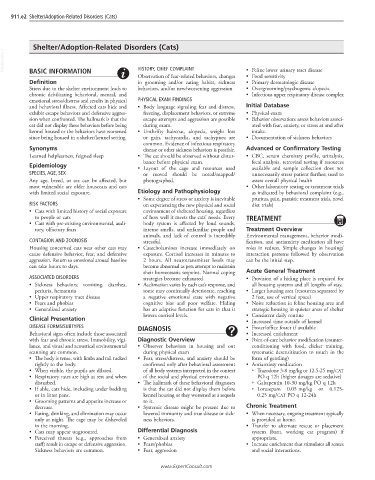Page 1820 - Cote clinical veterinary advisor dogs and cats 4th
P. 1820
911.e2 Shelter/Adoption-Related Disorders (Cats)
Shelter/Adoption-Related Disorders (Cats)
VetBooks.ir
HISTORY, CHIEF COMPLAINT
BASIC INFORMATION
• Food sensitivity
Observation of fear-related behaviors, changes • Feline lower urinary tract disease
Definition in grooming and/or eating habits, sickness • Primary dermatologic disease
Stress due to the shelter environment leads to behaviors, and/or new/worsening aggression • Overgrooming/psychogenic alopecia
chronic debilitating behavioral, mental, and • Infectious upper respiratory disease complex
emotional stress/distress and results in physical PHYSICAL EXAM FINDINGS
and behavioral illness. Affected cats hide and • Body language signaling fear and distress, Initial Database
exhibit escape behaviors and defensive aggres- freezing, displacement behaviors, or extreme • Physical exam
sion when confronted. The hallmark is that the escape attempts and aggression are possible • Behavior observation: assess behaviors associ-
cat did not display these behaviors before being during exam. ated with fear, anxiety, or stress at and after
kennel housed or the behaviors have worsened • Unthrifty haircoat, alopecia, weight loss intake.
since being housed in a shelter/kennel setting. or gain, tachycardia, and tachypnea are • Documentation of sickness behaviors
common. Evidence of infectious respiratory
Synonyms disease or other sickness behaviors is possible. Advanced or Confirmatory Testing
Learned helplessness, feigned sleep • The cat should be observed without distur- • CBC, serum chemistry profile, urinalysis,
bance before physical exam. fecal analysis, retroviral testing if resources
Epidemiology • Layout of the cage and resources used available and sample collection does not
SPECIES, AGE, SEX or moved should be noted/mapped/ unnecessarily stress patient further; used to
Any age, breed, or sex can be affected, but photographed. assess overall physical health
most vulnerable are older housecats and cats • Other laboratory testing or treatment trials
with limited social exposure. Etiology and Pathophysiology as indicated by behavioral complaint (e.g.,
• Some degree of stress or anxiety is inevitable pruritus, pain, parasitic treatment trials, novel
RISK FACTORS on experiencing the new physical and social diet trials)
• Cats with limited history of social exposure environment of sheltered housing, regardless
to people or cats of how well it meets the cats’ needs. Every TREATMENT
• Cats with pre-existing environmental, audi- body system is affected by loud sounds,
tory, olfactory fears intense smells, and unfamiliar people and Treatment Overview
animals, and lack of control is incredibly Environmental management, behavior modi-
CONTAGION AND ZOONOSIS stressful. fication, and antianxiety medication all have
Housing concerned cats near other cats may • Catecholamines increase immediately on roles in redress. Simple changes in housing/
cause defensive behavior, fear, and defensive exposure. Cortisol increases in minutes to interaction patterns followed by observation
aggression. Return to emotional arousal baseline 2 hours. All neurotransmitter levels may can be the initial step.
can take hours to days. become abnormal as pets attempt to maintain
their homeostatic setpoint. Normal coping Acute General Treatment
ASSOCIATED DISORDERS strategies become exhausted. • Provision of a hiding place is required for
• Sickness behaviors: vomiting, diarrhea, • Acclimation varies by each cat’s response, and all housing systems and all lengths of stay.
periuria, hematuria some may continually deteriorate, reaching • Larger housing area (resources separated by
• Upper respiratory tract disease a negative emotional state with negative 2 feet, use of vertical space)
• Fears and phobias cognitive bias and poor welfare. Hiding • Noise reduction in feline housing area and
• Generalized anxiety has an adaptive function for cats in that it strategic housing in quieter areas of shelter
lowers cortisol levels. • Consistent daily routine
Clinical Presentation • Increased time outside of kennel
DISEASE FORMS/SUBTYPES DIAGNOSIS • Foster/office foster if available
Behavioral signs often include those associated • Increased enrichment
with fear and chronic stress. Immobility, vigi- Diagnostic Overview • Point-of-care behavior modification (counter-
lance, and visual and acoustical environmental • Observer behaviors in housing and out conditioning with food, clicker training,
scanning are common. during physical exam systematic desensitization to touch in the
• The body is tense, with limbs and tail tucked • Fear, stress/distress, and anxiety should be form of gentling)
tightly to the body. confirmed only after behavioral assessment • Antianxiety medication
• When visible, the pupils are dilated. of all body systems interpreted in the context ○ Trazodone 3-8 mg/kg or 12.5-25 mg/CAT
• Respiratory rates are high at rest and when of the social and physical environments. PO q 12h (higher dosages are sedative)
disturbed. • The hallmark of these behavioral diagnoses ○ Gabapentin 10-30 mg/kg PO q 12h
• If able, cats hide, including under bedding is that the cat did not display them before ○ Lorazepam 0.05 mg/kg or 0.125-
or in litter pans. kennel housing or they worsened as a sequela 0.25 mg/CAT PO q 12-24h
• Grooming patterns and appetite increase or to it.
decrease. • Systemic disease might be present due to Chronic Treatment
• Eating, drinking, and elimination may occur lowered immunity and true disease or sick- • When necessary, ongoing treatment typically
only at night. The cage may be disheveled ness behaviors. is provided at home.
in the morning. • Transfer to alternate rescue or placement
• Cats may appear ungroomed. Differential Diagnosis system (barn, working cat program) if
• Perceived threats (e.g., approaches from • Generalized anxiety appropriate.
staff) result in escape or defensive aggression. • Fears/phobias • Increase enrichment that stimulates all senses
Sickness behaviors are common. • Fear, aggression and social interactions.
www.ExpertConsult.com

